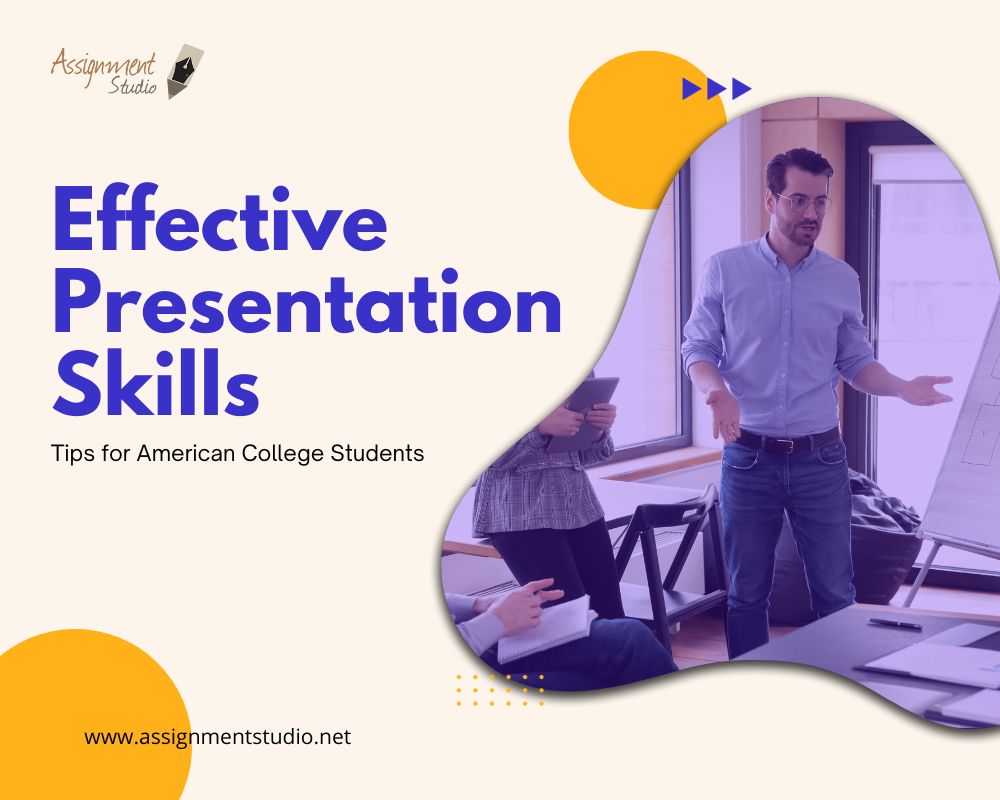
Giving presentations can be a daunting task, especially if you are afraid of speaking in front of people. College students are often asked to prepare presentations and that can become a huge source of stress for them. However, if you possess the right PowerPoint tips, public speaking and plenty of practice, you can ace that presentation like a pro. In this blog, we will discuss some of the best and most effective presentation tips for American College Students.
Table of Contents
A Road Map for Your Presentation
The most important element of a presentation is to conceptualise and frame your topic. Choosing how you will begin and conclude your topic is one of the most crucial decisions. Another thing is to know the audience you will be presenting in front of and how interested they will be in the topic. This way you will be able to determine how you will begin your presentation.
However, it doesn’t mean that the introduction can make or break your topic, it is an important part however mostly your presentation depends on how persuasive you can be or if you have the ability to make people second your argument.
Practice
You must have heard the saying, “Practice Makes You Perfect” Well, that is absolutely true. Without practice being good at anything is impossible and that is especially true for presentations. It takes time to become accustomed to standing in front of a number of people and presenting your views on a topic confidently.
Practice speaking in front of a friend or a coworker to determine which section needs improvement. You can also record yourself and listen to it later as listening to these later can help you become aware of mistakes you haven’t noticed before.
Know More Than You Are Planning to Share
Before creating your presentation, it’s essential to thoroughly research and gather relevant information about your topic. While it’s natural to want to share all your knowledge with the audience, it’s not always the best approach. Based on our experience, it’s more effective to limit the information you include to what can be presented with examples and evidence within the allocated time.
If you go overboard and try to cover every point you’ve studied, your presentation may end up rushed and confusing. Your audience may struggle to grasp your main points, resulting in a chaotic presentation. Instead, consider these recommendations:
- Dive deeper into the topic and provide more detailed information.
- Rather than discussing the topic broadly, focus on specific aspects.
By following these guidelines, you can enhance your audience’s understanding of your presentation.
Work On Your Body Language
“Body language is a great way of speaking.”
You may be wondering what body language has to do in a presentation. Well, it has more to do than you may think. Just as you put effort into selecting the right words and images and deciding where to place them, it’s equally important to consider how you use your hands and eyes and how you present yourself. During a presentation, the audience pays attention to two crucial aspects: your spoken words and your body language, also known as nonverbal communication. Nonverbal communication is an integral part of your presentation and can significantly impact its success or failure. Nonverbal cues are powerful indicators of your genuine emotions. If you tend to get nervous when presenting, this can work against you. However, there’s no need to worry because it’s a skill that can be learned and perfected through practice. Body language is heavily influenced by five key nonverbal cues that you should be mindful of when presenting:
- Hand Gestures: It’s essential to understand that the purpose of using hand gestures in a presentation is to make your message clearer, not more complex. Avoid overly exaggerated gestures, as they can be distracting. Instead, use gestures that enhance the impact of your points.
- Eye Contact: Human eyes can convey a wide range of emotions, to the extent that we can understand a person’s message solely from their eye movements. When presenting, aim for about 50% eye contact as you speak, and make sure to look around the room attentively to demonstrate your confidence and interest in the subject.
- Posture: Your posture can reveal whether you’re a nervous presenter or if you’re apprehensive about your audience. To gain your audience’s trust and undivided attention, stand with your feet apart, shoulders relaxed, and in a naturally confident position. This posture conveys your authority and invites your audience in.
- Movement: Some may believe that delivering a speech while standing still, like a statue, is the right way to present. However, we are human beings, and it’s not in our nature to remain completely motionless. The key is not to wander aimlessly but to move purposefully between key points while describing less critical details of your presentation. Use your movement to emphasise your statements and pause strategically to make an impact.
- Facial Expressions: Use your facial expressions to convey emotions, enthusiasm, and engagement. Your face can help captivate and connect with your audience.
In summary, body language in your presentation is as significant as your spoken words, and understanding and mastering these nonverbal cues can greatly enhance your communication with your audience.
Manage Your Time Well
Effective presentation requires careful time management. It’s crucial to stick to the given time limit to keep your audience engaged and deliver a clear message. To do this, you need to prepare thoroughly. Start by organising your content with specific time slots for each part. Practise your presentation multiple times, keeping an eye on your timing to make necessary adjustments. Staying within the time limit not only shows your respect for your audience’s time but also builds your credibility as a presenter. This approach ensures an organised and impactful delivery, letting you cover important points without rushing or making the presentation overly long.
Avoid Reading the Script
When you’re giving a presentation, it’s best not to read word-for-word from your notes or slides. Instead, rely on bullet points or key phrases. This helps you speak more naturally and engage your audience. Practise your presentation until you’re comfortable discussing each point without reading. This way, you’ll come across as more confident and knowledgeable. It also allows you to maintain better eye contact with your audience, making the presentation more engaging and effective. Remember, your slides or notes are there to support you, not to replace your speech. So, practice and be prepared to talk about your topic in your own words.
Stay Calm and Be Adaptable
Maintain composure if something goes wrong during your presentation. Stay calm and adapt to the situation, ensuring you carry on with confidence. Flexibility and a cool head can help you overcome challenges and deliver a successful presentation.
Remember that effective presentations require practice and continuous improvement. The more you present, the better you’ll become. Embrace each presentation as an opportunity to develop your skills and gain confidence.







